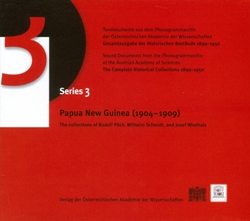
The historical material of the Phonogrammarchiv, the worl’s oldest sound archive, comprises ca. 4000 recordings, so-called Phonogramme and gramophone discs. The decision in favor of a complete edition was to a large extent motivated by increased interest in these recordings from outside the narrow circle of research institutions concerned with sound archiving. In many cases, the historical recordings are the earliest of their kind, documenting cultures and languages which have since been subject to fundamental changes. Some of the recordings preserve cultures or styles of expression that no longer exist in the form preserved here. These collections, therefore, are also attracting the attention of a general public interested in culture and histroy, especially in the regions of their origin.
The series of the Complete Edition of the Historical Recordings 1899-1950, begun in 1999 on the occasion of the 100th anniversary of the existence of the Phonogram Archive, is continued in series 3, Papua New Guinea (1904-1909), the collections of Rudolf Pöch, Wilhelm Schmidt, and Josef Winthuis.
The core of the series “Papua New Guinea (1904-1909)” are the famous recordings of Rudolf Pöch. Pöch was a pioneer in many respects: he systematically employed photographic, phonographic and cinematographic techniques for anthropological purposes. He was the first scholarly employee of the Phonogrammarchiv, the first academic teacher and, eventually, the first chair of anthropology at the University of Vienna. His second expedition to South-west Africa 1907-1909 will be published later in the course of this edition. Along with the Pöch-materials from Papua New Guinea, the other historical holdings of that region are published within the series; the collection of Father Wilhelm Schmidt, the founder of the Vienna School of Anthropology, and Josef Winthuis.All these recordings are documents of cultural expressions which have considerably changed since the time of recording. It can be assumed that the historical ethnography of this region will profit considerably from this publication.
The edition of these historical sound documents on CD is meant to make possible easy access, not only to the sound documents as such. They are therefore accompanied by the original protocols, published on a CD-Rom as digital images, while a commentary section.
…
Das Phonogrammarchiv verfügt als ältestes Schallarchiv der Welt über einen Bestand von rund 4000 historischen mechanischen Tonträgern (Phonogramme und Grammophonplatten), die von der Jahrhundertwende bis ca. 1950 aufgenommen und archiviert wurden. Vielfach stellen die historischen Bestände die ältesten ihrer Art dar, oft dokumentieren sie Kulturen und Sprachen, die in der Zeit seit ihrer Aufnahme starken Veränderungen unterworfen wurden, bisweilen sind sie auch Zeugnisse längst vergangener Kulturen bzw. Ausdrucksformen. Daher gewinnen die Sammlungen über ihren wissenschaftlichen Aspekt hinaus auch Bedeutung für weitere, kulturell und historisch interessierte Kreise, insbesondere in ihren Ursprungsländern.
Die 1999 anläßlich des 100-jährigen Bestandes des Phonogrammarchivs begonnene Serie der Gesamtausgabe der Historischen Bestände 1899-1950 findet in der Serie 3, Papua Neuguinea, ihre Fortsetzung.
Rudolf Pöchs Tonaufnahmen aus Neuguinea entstanden in den Jahren 1904 bis 1906 und gehören zu den frühen Meilensteinen phonographischer Sammeltätigkeit. Pöch gilt als erster moderner Feldforscher, der multimedial – nämlich mit Phonograph, Fotoapparat und Filmapparat – arbeitete. Er war kurze Zeit als Assistent im Phonogrammarchiv tätig, bevor er als erster den Lehrstuhl für Anthropologie der Universität Wien bekleidete. Pöchs zweite große Feldforschungsreise führte ihn zwischen 1907 bis 1909 nach Südwestafrika. Diese Aufnahmen werden mit den anderen historischen Aufnahmen aus dieser Region publiziert werden.
Die Neuguinea-Aufnahmen von Pöch umfassen drei der hier publizierten CDs, auf einer weiteren sind die Aufnahmen von Pater Wilhelm Schmidt, dem Gründer der Wiener anthropologischen Schule, aus dem Jahr 1907 zu hören, die fünfte CD enthält die Aufnahmen von Josef Winthuis aus den Jahren 1908 und 1909.
Diese akustischen Dokumente überliefern kulturelle Äußerungen, die sich seit der Zeit der Aufnahmen durchaus verändert haben. Deshalb sind sie für eine historische Ethnographie dieser Region sehr wichtig.
Mit der Herausgabe dieser historischen Tondokumente auf CD möchte das Phonogrammarchiv einen leichten, dezentralen Zugriff ermöglichen, der nicht nur das Tondokument selbst betrifft. Auf einer CD-Rom werden die Originalprotokolle in Form digitaler Bilder veröffentlicht, während ein Kommentarteil aus rezenter Sicht zu den historischen Beständen, insbesondere zu ihrem Entstehen, Stellung nimmt, um eine weitere Bearbeitung zu erleichtern, ohne diese jedoch vorwegzunehmen. Orientierungs-Transkriptionen/Transliterationen der aufgenommenen Melodien bzw. Texte sollen den Zugang zu den wegen ihrer historischen Tonqualität oft schwer wahrnehmbaren Aufnahmen erleichtern.
Als Tondokumente von hervorragender Bedeutung wurden die Historischen Bestände 1899-1950 des Phonogrammarchivs von der UNESCO in das Weltregister des Memory of the World Programmes aufgenommen.
978-3-7001-2920-2
5 CDs, 1 CD-ROM, Booklet mit 223 Seiten